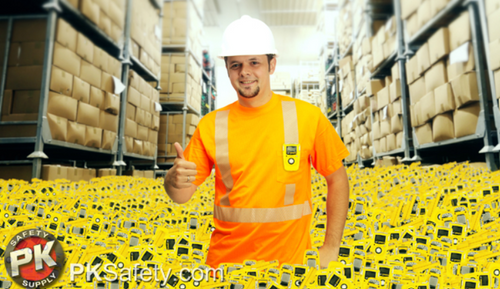What are the Differences Between Single-Gas H2S Monitors?
Here at PK we sell lots of gas monitors. A large portion of those sales are for single gas hydrogen sulfide (H2S) monitors. Because we sell several brands and models of single gas monitors, the question is inevitably "what's the difference?"
First let's start with the industry leader in single-gas H2S monitors - the BW Honeywell Clip H2S Monitor. This is a 2-year, fixed-life monitor that requires virtually no maintenance. With the single-gas BW Clip there's no need to change batteries or sensors during the life of the monitor. After two years, you simply throw it away. It's the original disposable gas monitor.
This type of monitor is preferred in big operations like refineries and drilling rigs where there are lots of employees and they require basic information. If the alarm goes off, it's time to get out of there. One part per million here or there probably doesn't make a big difference for these guys. If the monitor is supposed to go into alarm at 10 parts per million (PPM), and it goes off at 9 or 11, it's not going to ruffle any feathers.
The companies that tend to buy these monitors are looking for a durable, reliable monitor that meets minimum safety requirements and that they don't have to mess with much. Operating the BW GasAlert Clip Extreme doesn't mean a complete lack of maintenance, but the requirements are minimal. Users bump test regularly to make sure the monitors are registering the gas.
In a facility where a high degree of accuracy is required, calibration and a higher degree of technical sophistication will also be needed. On work sites with higher tolerances in regard to gas detection, the BW monitor probably isn't going to be their first choice. The next step up from the BW monitor would be something like the RAE Systems ToxiRAE 3.
The ToxiRAE has a digital readout with sensitivity available down to .1 ppm. In order to know the monitor is measuring gas as accurately as possible, regular calibration must be performed in addition to bump testing. The ToxiRAE 3 has three different sensitivity options which make it easier for some companies to get exactly what they need.
Another nice thing about this RAE Systems monitor is the one-button interface. It's been our experience that some two-button gas monitors aren't very intuitive. We've been working with gas monitors since the mid-70s when detectors needed to be calibrated at least once or twice a day. If we are getting lost in the interface, we think the average worker in the field has a real good chance of having problems.
The ToxiRAE 3, even though it is about $100 more than the BW model, has several distinct advantages. The biggest one is the lack of the built-in life range. An easily replaceable battery makes it possible to get the most out of your H2S sensor no matter how many times the unit goes into alarm.
Another good option for a single gas H2S monitor is the MSA Altair. This is another single-gas H2S monitor with a constant digital readout of gas levels. Again, it's a product like the ToxiRAE 3, that needs to be regularly calibrated to maintain accuracy. It has a one-button interface that is simple for users. And the cost per unit is about $40 less expensive than the RAE monitor.
For $195 the Draeger Pac 3500 H2S monitor provides probably the most state-of-the-art sensor technology. The Pac 3500 monitors also provide constant readout and resolution down to .1 ppm along with adjustable alarm levels. These monitors are for companies or facilities where a very high value is placed on accuracy, and the level of technical sophistication is also high.
The Draeger 3500 monitors come with the two-year built-in life span. Some folks like this. They can plan on buying new monitors when the old batch expires. It helps with planning and budgeting.
At the end of the day, all of these monitors are going to help your company be compliant and keep workers safe. The level of accuracy required for your particular job site will be a determining factor in finding the right brand and model. If you have questions, we have factory-trained technicians on staff. Please don't hesitate to call or contact us online at pksafety.com.
As always, thanks for reading.
Recent Posts
-
The Best Cold Weather Gloves for Package Handlers and Delivery Drivers | PK Safety
Best Gloves for Package Handlers During the Holiday Season As the holiday season approaches, pa …Nov 11th 2024 -
Why Hi-Vis Winter Work Gear is Essential for Safety During the Cold Months | PK Safety
When temperatures drop and daylight hours shrink, outdoor workers face additional hazards that incre …Oct 31st 2024 -
Self Braking Descender: Advanced Rope Control for Fall Protection | PK Safety
For professionals working at heights, controlled descent is critical. Whether you’re a window cle …Oct 30th 2024





